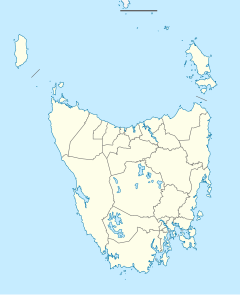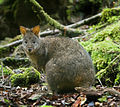Strzelecki National Park
| Strzelecki National Park | ||
|---|---|---|
|
|
||
| Location: | Tasmania , Australia | |
| Specialty: | Coastal and mountain landscape | |
| Next city: | Flinders Island | |
| Surface: | 42.16 km² | |
| Founding: | 1967 | |
| Address: |
Strzelecki National Park Park Office PO Box 41 Whitemark TAS 7255 |
|
| Location of Flinders Island (marked in green) | ||
The Strzelecki National Park (English Strzelecki National Park ) is a national park in the southwest of Flinders Island off the Australian island of Tasmania . The distance to Hobart is 307 km south. It was named after Sir Paul Edmund Strzelecki , a well-known Polish explorer and researcher. He climbed a large number of mountain peaks on Flinders Island in 1842.
nature and landscape
The landscape is characterized by spectacular coastlines and granite mountains. As in large parts of Tasmania, the vegetation in the national park is also shaped by the precipitation and the intensity of the fires that occur. In addition, the distribution limits of many species of fauna and flora of Australia and Tasmania overlap in the area, which is why it is of particular biogeographical importance. That is why the national park is rich in endemic species and provides a livelihood for rare animal and plant species.
Flora and fauna
Trees from the genera Leptospermum , the casuarina family and Acacia are widespread in the park ; Depending on the site conditions, however, different eucalyptus species can also be found.
13 plant species that are classified as endangered find their habitat in the park. These include a number of terrestrial orchids, but their populations are endangered by feral pigs, as these can damage the plants while they are looking for food.
- Mammal species in the Strzelecki National Park
Wombats , red-necked wallaby and red-bellied filanders are common mammals to see in the park. The rabbit kangaroo species Potorous tridactylus is less common . Birds have so far been recorded in 114 species in the park, which underlines the importance of the area as a stopover on the migration of many species. The rarer species include the swallow parakeet , the tasman panther , the gray- tailed sandpiper and the endangered plover Thinornis rubricollis .
Of the 19 reptiles found in Tasmania, nine have also been found in the national park. Among them are the snake species Black Tiger Otter and Drysdalia coronoides that Agamenart Rankinia diemensis and six skinks . Of the nine observed amphibian species, the threatened tree frog Litoria raniformis, which belongs to the Litoria aurea complex, is particularly worth mentioning.
Access to the park
Flinders Island can be reached by air and water. Flights are available from Launceston, Tasmania and Moorabbin, Victoria. There is no public transport on the island itself, but cars and bicycles can be rented in Whitemark.





